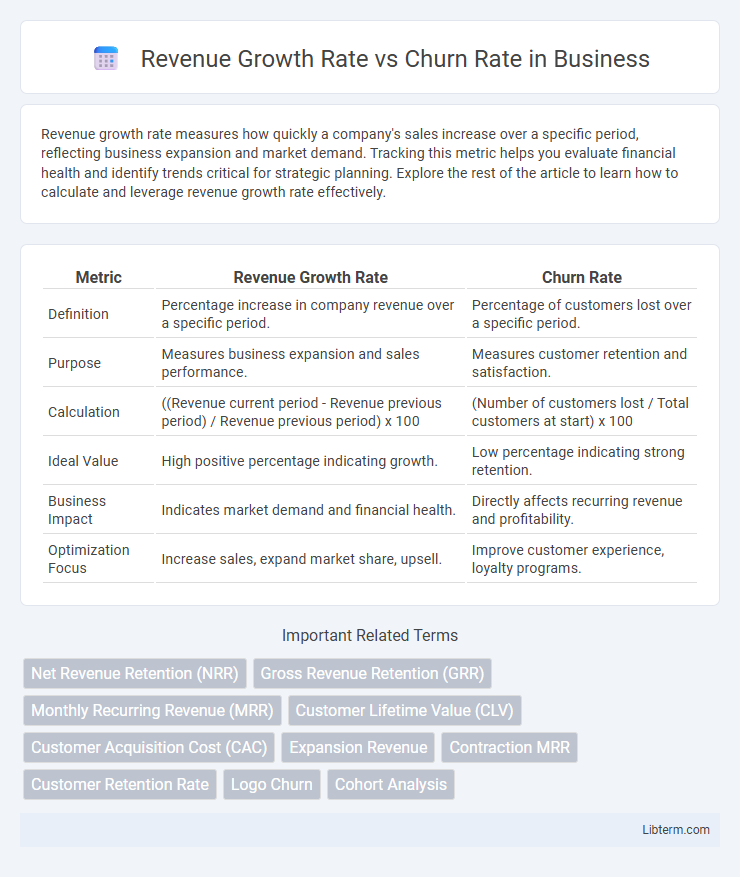Revenue growth rate measures how quickly a company's sales increase over a specific period, reflecting business expansion and market demand. Tracking this metric helps you evaluate financial health and identify trends critical for strategic planning. Explore the rest of the article to learn how to calculate and leverage revenue growth rate effectively.
Table of Comparison
| Metric | Revenue Growth Rate | Churn Rate |
|---|---|---|
| Definition | Percentage increase in company revenue over a specific period. | Percentage of customers lost over a specific period. |
| Purpose | Measures business expansion and sales performance. | Measures customer retention and satisfaction. |
| Calculation | ((Revenue current period - Revenue previous period) / Revenue previous period) x 100 | (Number of customers lost / Total customers at start) x 100 |
| Ideal Value | High positive percentage indicating growth. | Low percentage indicating strong retention. |
| Business Impact | Indicates market demand and financial health. | Directly affects recurring revenue and profitability. |
| Optimization Focus | Increase sales, expand market share, upsell. | Improve customer experience, loyalty programs. |
Understanding Revenue Growth Rate
Revenue Growth Rate measures the percentage increase in a company's sales over a specific period, serving as a key indicator of business expansion and market demand. Tracking this metric alongside customer acquisition and retention strategies provides insights into overall financial health and operational efficiency. Businesses with a consistently high Revenue Growth Rate typically outperform competitors by successfully scaling products, services, and customer engagement.
Defining Churn Rate
Churn rate measures the percentage of customers who discontinue their subscription or stop using a service within a given period, reflecting customer attrition and impacting overall revenue stability. A high churn rate indicates significant loss of customers, which can hinder revenue growth despite new customer acquisitions. Monitoring churn rate alongside revenue growth rate provides critical insights into customer retention effectiveness and long-term business sustainability.
Key Differences Between Revenue Growth and Churn
Revenue growth rate measures the increase in a company's income over a specific period, reflecting its ability to acquire new customers and expand sales. Churn rate quantifies the percentage of customers lost during a timeframe, indicating customer retention challenges. While revenue growth emphasizes overall business expansion, churn rate highlights customer attrition, making both crucial for assessing financial health and long-term sustainability.
Why Both Metrics Matter for Businesses
Revenue Growth Rate and Churn Rate are critical indicators that collectively reveal a business's financial health and customer retention effectiveness. A high Revenue Growth Rate signals successful customer acquisition and increased sales, while a low Churn Rate indicates strong customer loyalty and satisfaction. Monitoring both metrics allows companies to balance growth strategies with retention efforts, ensuring sustainable long-term profitability.
Calculating Revenue Growth Rate
Calculating revenue growth rate involves measuring the percentage increase in a company's revenue over a specific period, typically using the formula: ((Current Period Revenue - Previous Period Revenue) / Previous Period Revenue) x 100. This metric helps businesses assess their financial progress and market expansion efficiency. Accurate calculation requires consistent revenue data, allowing comparison with churn rate to understand customer retention impact on revenue sustainability.
Methods to Measure Churn Rate
Measuring churn rate involves calculating the percentage of customers who discontinue service within a specific period, using formulas such as (Customers Lost / Total Customers at Start) x 100. Tracking customer cancellations, subscription expirations, and service downgrades through CRM systems or subscription management software provides precise data for churn analysis. Cohort analysis and customer surveys also help identify patterns and reasons behind churn, enabling businesses to implement targeted retention strategies.
Impact of High Churn on Revenue Growth
High churn rate significantly hinders revenue growth by increasing customer acquisition costs and reducing the lifetime value of each customer. Companies experiencing elevated churn struggle to maintain consistent revenue streams, forcing them to allocate more resources toward attracting new customers rather than expanding existing accounts. Sustainable revenue growth depends on minimizing churn while enhancing customer retention strategies to foster steady, long-term income stability.
Strategies to Increase Revenue Growth Rate
Implement targeted upselling and cross-selling strategies to existing customers, leveraging data analytics to identify high-potential segments. Enhance customer retention by improving product value and customer support, which indirectly boosts revenue growth by reducing churn rate. Invest in diversified marketing campaigns and new product development to expand market reach and attract new customers, driving sustainable revenue growth.
Reducing Churn Rate: Best Practices
Reducing churn rate is essential for sustaining revenue growth rate, as retaining existing customers costs significantly less than acquiring new ones. Implementing personalized customer engagement, proactive support, and regular feedback loops helps identify pain points and enhance satisfaction. Leveraging data analytics to predict churn and deploying targeted retention strategies further minimizes customer loss, driving consistent revenue expansion.
Balancing Revenue Growth and Churn for Sustainable Success
Balancing revenue growth rate and churn rate is crucial for sustainable business success, as rapid revenue growth can be undermined by high customer churn, leading to net losses. Companies that closely monitor churn rate while driving revenue growth ensure long-term profitability by retaining a stable customer base and maximizing lifetime value. Optimizing strategies that simultaneously address customer acquisition and retention fosters consistent revenue expansion and reduces volatility in financial performance.
Revenue Growth Rate Infographic

 libterm.com
libterm.com